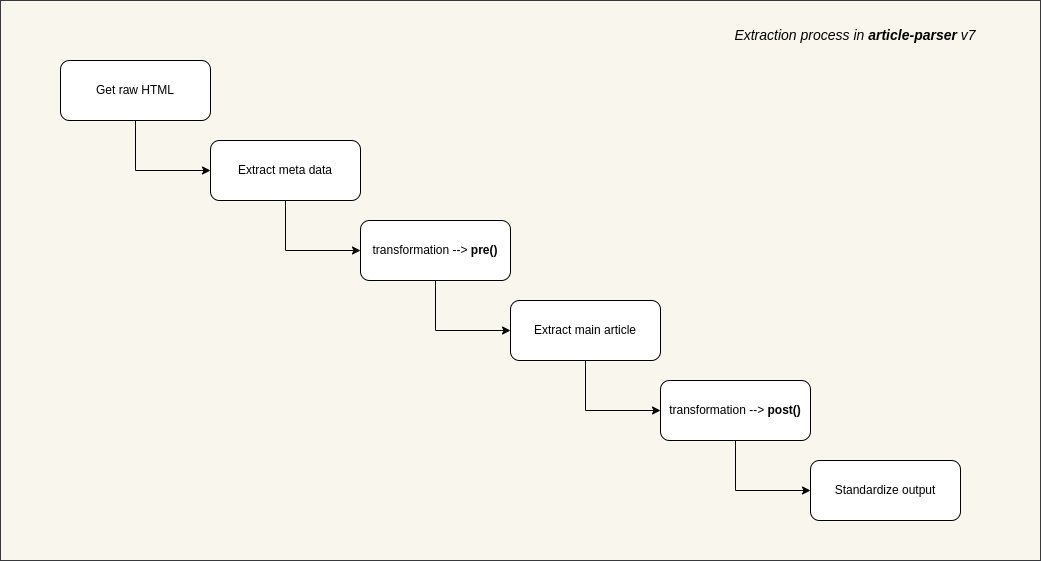
Security News
OpenJS: “XZ Utils Cyberattack Likely Not an Isolated Incident”
OpenJS is warning of social engineering takeovers targeting open source projects after receiving a credible attempt on the foundation.
@extractus/article-extractor
Advanced tools
Weekly downloads
Readme
Extract main article, main image and meta data from URL.
(This library is derived from article-parser renamed.)
npm i @extractus/article-extractor
# pnpm
pnpm i @extractus/article-extractor
# yarn
yarn add @extractus/article-extractor
// es6 module
import { extract } from '@extractus/article-extractor'
import { extract } from 'https://esm.sh/@extractus/article-extractor'
// deno > 1.28
import { extract } from 'npm:@extractus/article-extractor'
import { extract } from 'https://esm.sh/@extractus/article-extractor'
Please check the examples for reference.
extract()Load and extract article data. Return a Promise object.
extract(String input)
extract(String input, Object parserOptions)
extract(String input, Object parserOptions, Object fetchOptions)
Example:
import { extract } from '@extractus/article-extractor'
const input = 'https://www.cnbc.com/2022/09/21/what-another-major-rate-hike-by-the-federal-reserve-means-to-you.html'
// here we use top-level await, assume current platform supports it
try {
const article = await extract(input)
console.log(article)
} catch (err) {
console.error(err)
}
The result - article - can be null or an object with the following structure:
{
url: String,
title: String,
description: String,
image: String,
author: String,
favicon: String,
content: String,
published: Date String,
type: String, // page type
source: String, // original publisher
links: Array, // list of alternative links
ttr: Number, // time to read in second, 0 = unknown
}
input requiredURL string links to the article or HTML content of that web page.
parserOptions optionalObject with all or several of the following properties:
wordsPerMinute: Number, to estimate time to read. Default 300.descriptionTruncateLen: Number, max num of chars generated for description. Default 210.descriptionLengthThreshold: Number, min num of chars required for description. Default 180.contentLengthThreshold: Number, min num of chars required for content. Default 200.For example:
import { extract } from '@extractus/article-extractor'
const article = await extract('https://www.cnbc.com/2022/09/21/what-another-major-rate-hike-by-the-federal-reserve-means-to-you.html', {
descriptionLengthThreshold: 120,
contentLengthThreshold: 500
})
console.log(article)
fetchOptions optionalfetchOptions is an object that can have the following properties:
headers: to set request headersproxy: another endpoint to forward the request toagent: a HTTP proxy agentsignal: AbortController signal or AbortSignal timeout to terminate the requestFor example, you can use this param to set request headers to fetch as below:
import { extract } from '@extractus/article-extractor'
const url = 'https://www.cnbc.com/2022/09/21/what-another-major-rate-hike-by-the-federal-reserve-means-to-you.html'
const article = await extract(url, {}, {
headers: {
'user-agent': 'Opera/9.60 (Windows NT 6.0; U; en) Presto/2.1.1'
}
})
console.log(article)
You can also specify a proxy endpoint to load remote content, instead of fetching directly.
For example:
import { extract } from '@extractus/article-extractor'
const url = 'https://www.cnbc.com/2022/09/21/what-another-major-rate-hike-by-the-federal-reserve-means-to-you.html'
await extract(url, {}, {
headers: {
'user-agent': 'Opera/9.60 (Windows NT 6.0; U; en) Presto/2.1.1'
},
proxy: {
target: 'https://your-secret-proxy.io/loadXml?url=',
headers: {
'Proxy-Authorization': 'Bearer YWxhZGRpbjpvcGVuc2VzYW1l...'
},
}
})
Passing requests to proxy is useful while running @extractus/article-extractor on browser. View examples/browser-article-parser as reference example.
For more info about proxy authentication, please refer HTTP authentication
For a deeper customization, you can consider using Proxy to replace fetch behaviors with your own handlers.
Another way to work with proxy is use agent option instead of proxy as below:
import { extract } from '@extractus/article-extractor'
import { HttpsProxyAgent } from 'https-proxy-agent'
const proxy = 'http://abc:RaNdoMpasswORd_country-France@proxy.packetstream.io:31113'
const url = 'https://www.cnbc.com/2022/09/21/what-another-major-rate-hike-by-the-federal-reserve-means-to-you.html'
const article = await extract(url, {}, {
agent: new HttpsProxyAgent(proxy),
})
console.log('Run article-extractor with proxy:', proxy)
console.log(article)
For more info about https-proxy-agent, check its repo.
By default, there is no request timeout. You can use the option signal to cancel request at the right time.
The common way is to use AbortControler:
const controller = new AbortController()
// stop after 5 seconds
setTimeout(() => {
controller.abort()
}, 5000)
const data = await extract(url, null, {
signal: controller.signal,
})
A newer solution is AbortSignal's timeout() static method:
// stop after 5 seconds
const data = await extract(url, null, {
signal: AbortSignal.timeout(5000),
})
For more info:
extractFromHtml()Extract article data from HTML string. Return a Promise object as same as extract() method above.
extractFromHtml(String html)
extractFromHtml(String html, String url)
extractFromHtml(String html, String url, Object parserOptions)
Example:
import { extractFromHtml } from '@extractus/article-extractor'
const url = 'https://www.cnbc.com/2022/09/21/what-another-major-rate-hike-by-the-federal-reserve-means-to-you.html'
const res = await fetch(url)
const html = await res.text()
// you can do whatever with this raw html here: clean up, remove ads banner, etc
// just ensure a html string returned
const article = await extractFromHtml(html, url)
console.log(article)
html requiredHTML string which contains the article you want to extract.
url optionalURL string that indicates the source of that HTML content.
article-extractor may use this info to handle internal/relative links.
parserOptions optionalSee parserOptions above.
Sometimes the default extraction algorithm may not work well. That is the time when we need transformations.
By adding some functions before and after the main extraction step, we aim to come up with a better result as much as possible.
There are 2 methods to play with transformations:
addTransformations(Object transformation | Array transformations)removeTransformations(Array patterns)At first, let's talk about transformation object.
transformation objectIn @extractus/article-extractor, transformation is an object with the following properties:
patterns: required, a list of regexps to match the URLspre: optional, a function to process raw HTMLpost: optional, a function to process extracted articleBasically, the meaning of transformation can be interpreted like this:
with the urls which match these
patterns
let's runprefunction to normalize HTML content
then extract main article content with normalized HTML, and if success
let's runpostfunction to normalize extracted article content

Here is an example transformation:
{
patterns: [
/([\w]+.)?domain.tld\/*/,
/domain.tld\/articles\/*/
],
pre: (document) => {
// remove all .advertise-area and its siblings from raw HTML content
document.querySelectorAll('.advertise-area').forEach((element) => {
if (element.nodeName === 'DIV') {
while (element.nextSibling) {
element.parentNode.removeChild(element.nextSibling)
}
element.parentNode.removeChild(element)
}
})
return document
},
post: (document) => {
// with extracted article, replace all h4 tags with h2
document.querySelectorAll('h4').forEach((element) => {
const h2Element = document.createElement('h2')
h2Element.innerHTML = element.innerHTML
element.parentNode.replaceChild(h2Element, element)
})
// change small sized images to original version
document.querySelectorAll('img').forEach((element) => {
const src = element.getAttribute('src')
if (src.includes('domain.tld/pics/150x120/')) {
const fullSrc = src.replace('/pics/150x120/', '/pics/original/')
element.setAttribute('src', fullSrc)
}
})
return document
}
}
addTransformations(Object transformation | Array transformations)Add a single transformation or a list of transformations. For example:
import { addTransformations } from '@extractus/article-extractor'
addTransformations({
patterns: [
/([\w]+.)?abc.tld\/*/
],
pre: (document) => {
// do something with document
return document
},
post: (document) => {
// do something with document
return document
}
})
addTransformations([
{
patterns: [
/([\w]+.)?def.tld\/*/
],
pre: (document) => {
// do something with document
return document
},
post: (document) => {
// do something with document
return document
}
},
{
patterns: [
/([\w]+.)?xyz.tld\/*/
],
pre: (document) => {
// do something with document
return document
},
post: (document) => {
// do something with document
return document
}
}
])
The transformations without patterns will be ignored.
removeTransformations(Array patterns)To remove transformations that match the specific patterns.
For example, we can remove all added transformations above:
import { removeTransformations } from '@extractus/article-extractor'
removeTransformations([
/([\w]+.)?abc.tld\/*/,
/([\w]+.)?def.tld\/*/,
/([\w]+.)?xyz.tld\/*/
])
Calling removeTransformations() without parameter will remove all current transformations.
While processing an article, more than one transformation can be applied.
Suppose that we have the following transformations:
[
{
patterns: [
/http(s?):\/\/google.com\/*/,
/http(s?):\/\/goo.gl\/*/
],
pre: function_one,
post: function_two
},
{
patterns: [
/http(s?):\/\/goo.gl\/*/,
/http(s?):\/\/google.inc\/*/
],
pre: function_three,
post: function_four
}
]
As you can see, an article from goo.gl certainly matches both them.
In this scenario, @extractus/article-extractor will execute both transformations, one by one:
function_one -> function_three -> extraction -> function_two -> function_four
sanitize-html's options@extractus/article-extractor uses sanitize-html to make a clean sweep of HTML content.
Here is the default options
Depending on the needs of your content system, you might want to gather some HTML tags/attributes, while ignoring others.
There are 2 methods to access and modify these options in @extractus/article-extractor.
getSanitizeHtmlOptions()setSanitizeHtmlOptions(Object sanitizeHtmlOptions)Read sanitize-html docs for more info.
git clone https://github.com/extractus/article-extractor.git
cd article-extractor
pnpm i
pnpm test

git clone https://github.com/extractus/article-extractor.git
cd article-extractor
pnpm i
pnpm eval {URL_TO_PARSE_ARTICLE}
The MIT License (MIT)
If you find value from this open source project, you can support in the following ways:
Thank you.
FAQs
To extract main article from given URL
The npm package @extractus/article-extractor receives a total of 4,041 weekly downloads. As such, @extractus/article-extractor popularity was classified as popular.
We found that @extractus/article-extractor demonstrated a healthy version release cadence and project activity because the last version was released less than a year ago. It has 2 open source maintainers collaborating on the project.
Did you know?

Socket for GitHub automatically highlights issues in each pull request and monitors the health of all your open source dependencies. Discover the contents of your packages and block harmful activity before you install or update your dependencies.

Security News
OpenJS is warning of social engineering takeovers targeting open source projects after receiving a credible attempt on the foundation.

Company News
Come meet the Socket team at BSidesSF and RSA! We're sponsoring several fun networking events and we would love to see you there.

Security News
OSI is starting a conversation aimed at removing the excuse of the SaaS loophole for companies navigating licensing and the complexities of doing business with open source.